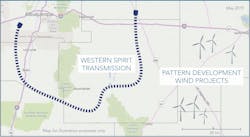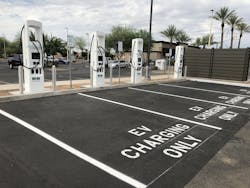Energy Goals: What Does a New Administration Mean for Utilities?
Shortly after Joe Biden’s inauguration as president, I attended an inaugural ball. Of course, given the times we live in, it was done remotely. People made repeated references to the coming new era for renewable energy investment and research. Aside from the fact I was attending the gala in joggers and a T-shirt, something felt extremely familiar about it.
It reminded me most vividly of the days after Barack Obama’s swearing in, when the American Recovery and Reinvestment Act was passed and dedicated billions of dollars to expanding energy infrastructure, including renewable energy. The topic of green jobs was on everyone’s lips, and it looked for a minute like we might build a whole new power grid — something we knew back then was badly needed, and not just for the people it would put back to work.
As the collapse of power grids in California and Texas — two of our most populous and politically influential states — have shown, we did not build the grid we needed. California, mostly run by Democrats, has a grid that cannot safely operate in dry, windy conditions and must be shut down to prevent wildfires. Texas, synonymous with Republican rule, has an isolated, deregulated power grid that left whole cities shivering when subzero temperatures rolled in.
We did not build the new grid we needed, but we did succeed in adding a lot of renewable energy capacity — often criticized for being too hard to integrate into the T&D system, which was not designed for distant, distributed power generation. Even as more wind turbines and solar panels were deployed over the years, I heard dire predictions of the stress this intermittent resource would put on the system — particularly, though not exclusively, if the speaker had a whiff of fossil fuels about them. The grid has problems, certainly, but can they be blamed on green power? And if there are real problems around the corner of our renewable revolution, can we plan cleverly enough to avoid them?
Renewable Growth
Many wrote renewable energy off when Donald Trump came to the White House. The former president, who had a widely publicized feud with a Scottish wind farm even before he was president, went off on improvised riffs at rallies about imagined couples who could not watch their favorite shows on TV because it was a cloudy, calm day.
Kent Knutson, an energy market specialist for Hitachi ABB Power Grids who has followed the generation and transmission markets for many years, said despite all this, the picture was not as dim as it initially appeared.
“Since 2016, renewable development blossomed under Trump,” Knutson said. “And energy storage is big now; it hasn’t been since until this year or so. Trump was not bad for renewable energy.”
According to Knutson, this may be because federal energy policy took a pause under Trump and Senate Majority Leader Mitch McConnell, but then continued at the state level.
“Trump was not bad for renewable energy,” Knutson said. “Everybody and his brother — states, local governments, corporations, everybody — is mandating and setting carbon reduction goals. And a lot of it. There’s nothing about it that is driven by the federal government except for the [production tax credit (PTC) and investment tax credit (ITC)], which are huge drivers for wind energy as well as solar and energy storage.”
Just about every major solar power project under construction now has an energy storage component to it, Knutson said. Transmission is a hugely important component to expand renewable and distributed energy technology, yet the projects are slow to get siting or funding approvals. Knutson said the Biden administration and Federal Energy Regulatory Commission (FERC) are promoting faster permitting, which could be a plus for the industry.
Biden released executive orders Jan. 27, 2021, that promised to “tackle the climate crisis at home and abroad” by creating new White House positions and task forces as well as directing the Interior Department to review siting and permitting processes on federal lands. This has the stated goal of increasing renewable energy production on those lands and waters, by doubling offshore wind by 2030.
At the time, Biden said the country “needs millions of construction, manufacturing, engineering and skilled-trades workers to build a new American infrastructure and clean energy economy.”
The executive orders also directed officials to ensure federal infrastructure investment reduces climate pollution and federal permitting decisions consider the effects of greenhouse gas emissions and climate change. The orders called for a review of siting and permitting processes, including those in progress under the Federal Permitting Improvement Steering Council, and an acceleration of clean energy and transmission deployment. Agency heads now are tasked to review infrastructure projects and consult with state, local and Tribal officials to develop efficient timelines in accordance with the level of a project’s complexity, according to an executive orders.
Per Knutson, the top-10 investor-owned utility holding companies reported a record US$220.1 billion of T&D in-service additions over the past 10 years, or 54.7% of the $402.1 billion reported by all holding companies. The average annual growth rate in T&D for this group is 10.2% during the period.
“Whenever they do build a big high-voltage transmission line to enable more renewables, historically it has been absorbed almost instantly. Meaning you build this thing and then, all of a sudden, it’s loaded to capacity,” Knutson said.
This could be an indication of just how badly needed new transmission capacity is, Knutson said.
More Transmission Investment
Mike Garland, CEO of Pattern Energy, said in a statement to TransmissionHub that more power transmission investment is desperately needed.
“Upgrading transmission is going to be a key component in achieving the 2035 clean energy goals,” Garland said.
Pattern is a transmission line developer as well as an owner and operator of wind and solar projects in the U.S., Canada and Japan.
According to Garland, Pattern Energy’s Western Spirit transmission line, under construction in New Mexico, will help to add 1000 MW of new wind power to the grid, with the line being “a prime example of the type of innovative transmission projects that need to be supported, so that the U.S. can continue adding vital wind and solar power resources across the country.”
Pattern is codeveloping the nearly 150-mile (241-km), 345-kV Western Spirit line and associated wind projects with the New Mexico Renewable Energy Transmission Authority. The projects are slated for completion by the end of 2021, and the completed line will be owned and operated by the Public Service Co. of New Mexico in a deal worth $285 million.
This transmission project is a good example of how many different stakeholders can be brought together to ensure all that wind energy is put to good use on the power grid.
Integrating And Aggregating
David Brooks, vice president of integrated grid and energy systems at EPRI, said putting more renewable energy onto the power grid requires a reliable power asset, and through better policy and analytics, this can be done.
FERC’s Order 2222 is intended to make distributed energy resources (DERs) more valuable to utilities and grid operators by allowing the aggregation of multiple, distant sources of renewable power into a single, predictable resource.
“Wholesale electricity markets require market participants that are a minimum size to be able to include them within the markets. The FERC Order 2222 addresses barriers to allow small DERs, including those that can inject power to the transmission grid, to aggregate with others to meet a minimum size of 100 kW in order to participate,” Brooks said.
By lowering the total capacity requirement for participation to 100 kW and allowing heterogenous aggregations of various DER types (solar, battery storage and demand response) to make up that 100 kW, the order provides access to markets through third-party aggregators for DER projects that may not have been able to make a business case in the organized markets previously, Brooks explained.
However, Brooks said, integrating more renewables safely and reliably can be tricky. Many grid operators lack the processes and tools to analyze and monitor potential reliability challenges represented by bringing these new forms of generation on-line in large amounts.
“Most are considering or already implementing grid modernization plans to enable DER integration going forward, but developing these new capabilities will take both investment and time,” Brooks noted. “Plus, additional communication and coordination processes with the [independent system operators, regional transmission organizations] and DER aggregators will need to be developed.”
Brad Williams, vice president of industry strategy at Oracle Utilities, said there are regulatory barriers to distributed energy use that FERC’s order can address.
“FERC 2222 helps create more value for distributed energy resources owners and aggregators, but distribution utilities also need incentives from state regulators to participate with aggregators and get them to fully embrace using customer-owned DER as grid-side resources for non-wires alternatives,” Williams explained.
Order 2222 was finalized Sept. 17, 2020, and compliance filings for all jurisdictional independent system operators and regional transmission organizations are due to FERC on July 19, 2021. Those organizations will propose in their filings when they plan to implement the designs laid out in the compliance, which may be up to one year to two years beyond the July due date, said Brooks from EPRI.
Energy Storage
Geoff Blanford, senior technical executive with EPRI, said renewable energy technologies have grown in potential as they have dropped in cost.
“Technology costs have been declining. Did they decline as much as we foresaw? I’m not sure, but they have been really significant — especially solar but also wind. Nobody saw battery costs declining as fast as they have,” Blanford said.
EPRI data from the U.S. Regional Economy, Greenhouse Gas and Energy (US-REGEN) model documentation shows the cost projections for a 20-MW, 4-hour lithium-ion system decreased from $880/kW in 2019 to $705/kW. EPRI’s REGEN model shows the cost further decreasing to $570/kW by 2025.
By setting decarbonization goals and researching clean technology solutions, the commercial sector has been a powerful driver for renewables and DER adoption, Blanford noted.
“A driver of that was Tesla’s development of electric cars. You’ve also seen a lot of policy drivers apart from federal policies,” Blanford said.
As for Biden’s clean energy policy goals, Blanford said the energy sector would have to move quickly to catch up to the numbers Biden has stated.
“The Biden administration’s goal is net zero emissions economy-wide by 2050. It is not backed up with any specific plans, and 2035 for the electric sector was the target in the campaign. That’s not reflected in current legislation," Blanford observed.
Climate and energy issues are expected to be a major focus area for the 117th Congress, with the House building on its past efforts and kicking off climate hearings. The House Energy and Commerce Democrats released draft legislation titled the Climate Leadership and Environmental Action for our Nation’s (CLEAN) Future Act.
This legislation “would create a clean energy standard (CES) that would require retail electric suppliers to obtain 100% of their electricity from clean energy sources by 2050. It also included a host of provisions on transmission, electrification of the transportation sector, grid modernization, distributed energy resources, and hydropower, among others. The revised version of the bill is expected to require electric utilities to obtain 100 percent of their electricity from clean energy resources by 2035, in line with what the Biden Administration is seeking,” according to the American Public Power Association (APPA).
The House is expected to start considering broad, economy-wide energy legislation in the spring, including ways to promote energy efficiency, clean energy and e-transport. It also is likely to revisit tax supports for clean energy previously included in the Growing Renewable Energy and Efficiency Now (GREEN) Act and the Moving Forward Act.
In the Senate, Majority Leader Chuck Schumer has said climate legislation is a top priority. The Senate Energy & Natural Resources Committee will hold hearings on the Energy Policy Act of 2020 and how to implement it. That legislation included legislative supports for energy storage, efficiency and other advanced energy technologies for cutting carbon.
Desmarie Waterhouse, vice president of governmental relations and counsel for the APPA, said the association anticipates Congress to support utilities in making wind and solar a larger portion of their power supplies by bolstering infrastructure.
“We expect Congress to look for ways to expedite building new transmission needed to deliver electricity from remotely located renewable resources to population centers,” Waterhouse noted. “Congress will likely focus on ways to increase interregional transmission planning and remove barriers to siting through enhanced backstop authority.”
Waterhouse said that, while new transmission is needed intensely, Congress should not lose sight of protecting customers against rate hikes by keeping power costs low.
“With respect to distributed energy resources, there is a strong interest in promoting those resources. Congress may push policies to promote community solar projects as well as rooftop solar, with a focus on providing assistance to low-income and disadvantaged communities,” Waterhouse said.
With respect to renewable energy policy, Waterhouse said APPA’s preference is for Congress to foster a level playing field for utilities and renewable power producers.
“Should Congress extend the PTC and ITC, we are very hopeful Congress will also provide public power utilities with comparable incentives to enable them to make investments in wind and solar generation,” Waterhouse said. “If Congress is going to use the tax code to drive climate and clean energy policy, it needs to put public power utilities on a level playing field with for-profit entities by providing them with similar incentives.”
Blanford added that state renewable energy standards have, with few exceptions, achieved their goals of bringing more renewable energy on-line.
“Ohio, for example, backed off from their renewable standard, but most who have had renewable standards have met them,” said EPRI’s Blanford. “Most of the winds are blowing at the state level.”
State-Level DER Goals
Commissioner Maria S. Bocanegra of the Illinois Commerce Commission said she sees several states as leading the way on renewable integration: Maryland, Minnesota, Washington and California. But the advantage her state has is the ability to watch others learn which policies work best.
“Illinois is still in our infancy stages compared to states I mentioned when it comes to electrification policy, but for states like us, that gives us the opportunity to learn from other states,” Bocanegra explained.
Many utilities, too, are adopting a wait-and-see approach while testing out various technologies, with some being further along than others.
“There’s a trend within markets like Maryland and California that tend to be active on utility involvement. All of those at one point have visited the issue of whether utilities can install charging infrastructure. They’ve done it on a pilot basis, but now they are wondering how they can take it further,” she said.
Bocanegra agreed with Blanford about the commercial sector, at times, being a more powerful driver than traditional policy makers.
“The other thing we’re seeing on the utility side is fleet electrification. So, you think of Amazon, Fedex, Walmart. We’re seeing a lot of private companies come up with their own carbon goals and designs to decarbonize their supply chain. And so, utilities are having to face up to that,” Bocanegra said. “What we are used to seeing is utilities having to deal with legislature. But here, companies are leading the way and utilities are catching up.”
Of the Biden administration’s plans to prioritize getting more electric vehicles on the roads while beefing up the country’s charging infrastructure, Bocanegra said this plan will complement her own state’s objectives.
“For Illinois, we think that ambitious goal is compatible with our goal to implement a clean energy transition and economy. I wouldn’t be surprised to see state-level policy supports to dovetail with Biden’s policy,” she said.
Gov. J.B. Pritzker moved to electrify Illinois’ state-owned vehicle fleets, for a start. This is a move echoed by Biden’s executive order to establish an all-electric federal fleet.
“Beyond just electrifying transport, we have to think about V2G, batteries as a service. Those will be scaled up at local and national levels,” she noted, adding that she anticipates more memoranda of understanding by and between states to achieve such electrification goals.
For More Information
EPRI | www.epri.com
Hitachi ABB Power Grids | www.hitachiabb-powergrids.com
New Mexico Renewable Energy Transmission Authority | www.nmreta.com
Oracle Utilities | www.oracle.com
Pattern Energy | www.patternenergy.com
Public Service Co. of New Mexico | www.pnm.com
About the Author
Jeff Postelwait
Managing Editor
Jeff Postelwait is a writer and editor with a background in newspapers and online editing who has been writing about the electric utility industry since 2008. Jeff is senior editor for T&D World magazine and sits on the advisory board of the T&D World Conference and Exhibition. Utility Products, Power Engineering, Powergrid International and Electric Light & Power are some of the other publications in which Jeff's work has been featured. Jeff received his degree in journalism news editing from Oklahoma State University and currently operates out of Oregon.






